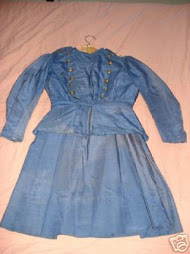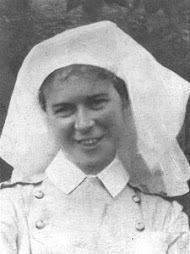Today’s blog is about Nursing Sister Christina Frederickson. Frederickson was a Canadian military nurse who didn’t die as a result of German bombs or torpedoes. Instead, she was struck down by a more powerful enemy—the Spanish influenza. There are many estimates as to the number of lives lost during the pandemic, but over 50 million people may have died as a result of the disease, with another 500 million infected. Many more lives were lost during the epidemic than the number lost in the Great War.
Frederickson was born in Skagafjord, Iceland in 1886. Her father was Frederick Frederickson and her mother was Guglaug Frederickson. She had at least five brothers and sisters, according to the 1916 Canadian census. The family lived in Manitoba. However, at the time of her enlistment in January 1918, Christina had moved to Edmonton. She may have been staying with her sister, who was a resident of the city. Her younger brother Walter, a steam traction engineer, had already enlisted in 1916.
Instead of being sent overseas, Frederickson—like hundreds of other nurses in the CAMC—served in a convalescent soldiers’ hospital in Canada. According to the newspaper, the Daily Telegraph, “up to October 5, 1916, the number of soldiers sent back to Canada because of medical unfitness was 6,208. Of these, 961 were suffering from wounds, shell-shock, or the effects of gas; 122 were insane; 245 were affected with tuberculosis; while the remainder, 4,880 were suffering from other diseases and disabilities”(quoted in Agnes Warner and the Nursing Sisters of the Great War by Shawna M. Quinn). Frederickson was a strong and stocky woman—5’6” tall and 160 pounds, an ideal candidate for the demanding work of caring for these men. The hospital to which she was assigned was the Strathcona Military Hospital in Edmonton (an institution which later became the University of Alberta Hospital).
Unfortunately, there was one disease that seemed to especially target healthy, young people such as Christine. That disease was the Spanish flu. While the cause of that particular strain of the virus has not yet been determined, what is known is that it was spread quickly by the massive troop movements that took place across the world during the Great War. Troops, already weakened by the trying conditions in which the war was taking place, were particularly susceptible to the disease. According to historian Diana Mansell, the disease “entered Canada on troop ships during the summer of 1918. Initially, the disease did not spread rapidly; however, it was obvious by the end of September that Canada had a problem. The epidemic adhered to historical tradition and travelled westerly across the country by means of the railway. This was a unique variety of flu in that it had a high morbidity rate and a much higher mortality rate than previously associated with flus…By 1918, Spanish Influenza had affected one in every six Canadians and killed between thirty and fifty thousand people.” (March 2001 email correspondence). One of the Canadians who died of the disease was Christina Frederickson.
According to the October 29, 1918 issue of the Edmonton Bulletin, Christina was working at the convalescent hospital when a call came for nurses to volunteer at an understaffed influenza hospital in the city. (At this point in the pandemic, hospitals were having a hard time finding nurses to serve those suffering from the disease.) “Nursing Sister Frederickson volunteered when the soldiers of the Siberian force were taken from a troop train some days since suffering from the influenza and placed in the isolation hospital to assist in nursing them, and she had been steadily at work with little respite up to the time that she herself became infected with the disease.”
It is instructive to read Frederickson’s military record for what it reveals about the course of this terrible disease. Christina became ill with the disease on October 24, 1918. She had a chill, coated tongue, cough, loss of appetite and occasional vomiting and “great prostration.” She was given quinine, apirin, and a laxative. The next day “symptoms continue severe.” Her chest “bubbled” and she had severe pain in that part of her body. She was given an expectorant. On the 26th, her symptoms continued, with no abatement of her fever. She coughed up blood. On the 27th, her right lung was clear, but by mid-day, her pulse was weak and she was perspiring. Her cheeks and fingertips were turning blue, a sign of oxygen deprivation. She was given camphor and caffeine to improve her pulse and respiration—but her symptoms did not improve. On the morning of the 28th she was cold and clammy. Christina was given more stimulants, including caffeine, camphor, adrenalin, strychnine, and whisky. By now she was “irrational.” By mid-day her condition worsened and despite “heroic treatment” she died at 5:30 p.m. Cause of death: epidemic influenza. While she didn’t die as a result of enemy fire, she was certainly a hero of the First World War.
Christina’s name was included on a war memorial set up in her home town of Glenboro, Manitoba. This can be seen on-line at:
http://www.mhs.mb.ca/docs/sites/glenborowarmemorial.shtml.
A special thanks to Annette Fulford for locating the Edmonton Bulletin article that announced Christina’s death.
Special Request
David Parsons, a fellow WWI historian, is asking for help in locating information about his aunt, Nurse Maysie Parsons. She served with a group of nurses who went to Belgium to nurse at a Dr LePage's hospital at De Panne, Belgium. He believes that they went overseas early in 1915, recruited by Madame Le Page of Montreal (who was later lost on the Lusitania). David has the names of three Newfoundland nurses who went to Le Page’s hospital in Belgium: Elsie Doyle, Emma Reid, and his aunt Maysie (she later served with the CAMC in Mudros at the 3rd Canadian Stationary Hospital). If you have any information to share, please send it to me at parsenippress@interbaun.com and I will forward it to David.
Happy Holidays
Finally, I’d like to wish everyone a very happy holiday and I look forward to continue my monthly blog in the new year!
Subscribe to:
Post Comments (Atom)






















No comments:
Post a Comment